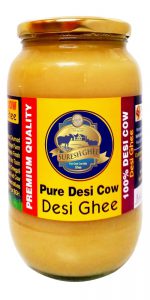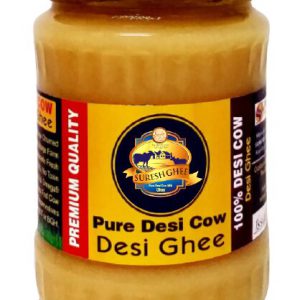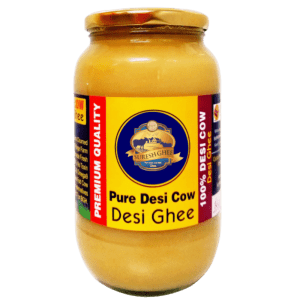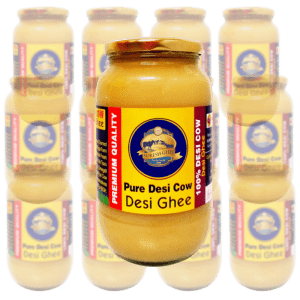Once you buy ghee on an online store during the festive season, you might be having questions like – does ghee go bad after the labelled expiry date? Can I use ghee even after the date labelled on the jar? This content will give you a piece of information about its storage, shelf life and other tips as well.
Ghee has an added advantage of its shelf life, besides the health benefits. It can be stored in airtight containers for about 8-12 months under proper packaging. It should not be exposed to moisture or sunlight.
When it is exposed to sunlight for a longer period of time it causes oxidation and the flavour gets off the ghee. If you are using an open jar to store ghee in your kitchen for daily use, then always check the smell, taste and colour of the ghee before use. You might be having a question – if ghee should be refrigerated for a better option? Ghee need not be refrigerated for up to 3 months of use. For a safer side, you can store ghee in the refrigerator for the rest of the year. Just follow these tips to maintain the quality and aroma of your organic ghee –
- Store ghee in an airtight container or glass jar.
- Use a clean and dry spoon while you take some ghee for use.
- Keep the jar in a dry and dark place.
- Do not let moisture enter your ghee as it will result in spoilage and may promote bacterial growth as well.
- It is also said that keeping a few smaller pieces of curry leaves or betel leaves can also help increase their shelf life.

Buy cow Ghee Online : Order Now. Free Shipping
Before you buy ghee you should consider a few packaging methods which are in turn related to the shelf life of the ghee.
Storage containers
Tin cans
Lacquer coated tin cans do not cause rusting. Whereas, rusted tins are responsible for lipid deterioration. These tin cans are usually used in bulk packaging of ghee. The only drawback when it comes to these tins is the cost. They are slightly costlier than the normal tins.
Glass bottles
Glass bottles are one of the most excellent containers to store ghee. They protect the quality of the ghee. These glass bottles are used for packaging small quantities like 100 gm – 500 gm. The only drawback of glass bottles is, that they should be well maintained without any breakages.

Buy cow Ghee Online : Order Now. Free Shipping
Semi-rigid plastic containers
The semi-rigid plastic containers are dominating most of the tin plate containers. They are usually made of high-density polyethene. These containers are used for small quantities as well as bulk quantities.
Pouches
The use of pouches has a good scope in today’s market. They are made from multilayer films of various compositions. Sachets made from a laminate of PVDC/ AI foil/ PP/ PVC are considered to be suitable for long-term storage of ghee. These flexible pouches are one of the cheapest forms of packaging.
How do you know if the ghee has gone bad?
Ghee usually gets rancid when stored for a too long period of time. It gets a sour flavour and an unusual smell. If you feel the ghee has got a terrible smell or there is a higher amount of discolouration or difference in the taste, it is better to stop using it.
Why does ghee have higher shelf life though it is made from the essence of milk?
Ghee has higher shelf life when compared with milk, curd or butter (unrefrigerated) because ghee has phospholipids that act as an antioxidant and also help in the preservation of ghee for a longer period of time at room temperature.
Is ghee dairy?
Officially ghee is a dairy but technically it is dairy-free. Though ghee is made from the essence of milk i.e butter, it is considered to be dairy-free. This is because the milk granules present in the butter get settled at the bottom of the pan when heated under a low flame.
The texture of ghee
Homemade ghee acquires a grainy texture once you let it cool down after its preparation. If you prefer soft and runny ghee, you can heat it up a little before use.
The ghee brought from stores may not be grainy or smooth in texture. It depends on the melting and crystallization of fats with respect to the temperature or climatic conditions. Though these conditions do not affect the quality, flavour or aroma of ghee. Thus the texture of ghee does not play a major role in maintaining a good shelf life of ghee.
How to check the purity of desi ghee?
Heat a pan and add a spoon of desi ghee. If the ghee turns reddish-brown in colour it is considered to be pure. Even when you take some ghee on your palm, it starts to melt which depicts purity.
Tests to check the purity of organic desi cow ghee:
Several tests can be done to check the purity of ghee at home. Some of these are mentioned below:
- Heat test: One of the simplest ways to find impurity of ghee is by heating a teaspoon of ghee in the vessel. While melting the colour of ghee is changed to dark brownish, then it is pure ghee. If it takes time to melt and the colour turns yellow then proves that it is adulterated.
- Palm test: Take a teaspoon of ghee at your palm, due to internal heat on the palm if ghee melts then it is pure. So pure ghee melts at body temperature.
- Double-boiler check: To check the traces of coconut oil in ghee, melt the ghee in a glass jar using a method of double-boiler and pour it into the glass jar. After that put the jar in the refrigerator for some time. If the solidification of ghee and coconut oil is done in a separate layer then ghee is impure.
- Hcl test: Heat a tablespoon of ghee in the test tube, add an equal proportion of concentrated HCL with a little sugar. Shake well and wait for five minutes and the pink or red colour in the lower layer shows that ghee is impure.
- Check off starch in ghee: In melted ghee add a few drops of iodine, if the colour turns purple that means ghee is adulterated with starch.
- Check with vegetable oil: Take a transparent bottle and add a teaspoon of melted ghee to that bottle. pinch of sugar added to the bottle, close the container and shake it well. Let’s wait for five minutes. If a layer of red colour appears at the bottom of vessels, then ghee contains vegetable oil.
Should desi ghee be a part of your diet?
A spoonful of desi ghee every day in your diet can make wonders!
Ghee is one such oil that was used as a basic cooking oil many years ago. Even in Ayurveda, ghee is used as an important medicine to cure various ailments. But presently other oils like olive oils, sunflower oils and groundnut oils have become dominant over ghee.
It is associated with and pushed away due to various myths about ghee. Don’t consider ghee as just mere fat. Fat is also one such essential element just like proteins, minerals or vitamins which helps for the proper functioning of the body.
Besides the taste and aroma of A2 desi cow ghee, it is beneficial for maintaining good health, curing various ailments and also enhance beauty. You can buy ghee at our online store. Visit our website https://sureshfoods.com to know more.
The importance of ghee can’t be emphasized enough, especially in our Indian culture. It’s rightly referred to as the Indian superfood which isn’t only delicious but has numerous health benefits.
However, concerns about weight gain and cholesterol make many of us avoid ghee. Desi cow ghee is extremely beneficial as long as you’re consuming it within the right quantity. Also, when consumed in the right quantities, neither does ghee cause weight gain nor does it contribute to a rise in cholesterol levels.
Other tips on how much ghee you should eat daily
According to nutritionists, you should add one tsp of cow ghee to each of the three meals: breakfast, lunch and dinner. Consumption of this much ghee can be helpful for women with PCOS, people with heart disease, high blood pressure, constipation, weak joints and inflammatory bowel syndrome (IBS).
Ghee for lunch
A spoon of ghee in lunch can do miracles for reducing junk food cravings and desserts later in the evening. It can also help in skipping post-lunch drowsiness, sluggishness and low productivity.
Ghee for dinner
An extra tsp along with 1 tsp of ghee in dinner can help with constipation and indigestion. Consumption of ghee at dinner also helps in improving your sleep quality.
Hence, an average of 3-6 tsp of ghee is suggested for good health and weight.
Can ghee be given during pregnancy?
A balanced diet is the most vital fact which should be followed during pregnancy. Ghee is the most essential soluble fat which is required for the proper functioning of the body and fats are one of the most integral parts of a balanced diet during pregnancy. But, consuming a larger amount of ghee than prescribed can lead to obesity or weight gain.
Read our blog – Ayurvedic ghee during pregnancy

Buy cow Ghee Online : Order Now. Free Shipping
Can ghee be given to infants?
Ghee can be given to infants once they attain the age of 6 months. Once the baby starts to grow elder, it requires more nutrition in the food. Only breast milk is not enough for the baby.
And the baby tends to lose the fat content of the breast milk after a certain time. Thus, ghee has a lot of loaded advantages to the little ones for their larger activities throughout the day!
Read our blog – When and how to give ghee to your baby, infant and its health benefits?
Desi cow ghee symbolizes purity and auspiciousness in India. Feel free to use ghee as basic cooking oil as it has a high smoke point. The shelf life of ghee is higher when compared to other dairy products. Remember to consume ghee in your diet without exceeding the calorie limit. Store ghee without letting it get in contact with moisture and use it every day.
FAQ
Contrary to common belief systems, ghee does not require refrigeration. It is positioned as a storage-friendly dairy product, either it is obtained from cow’s milk or other sources. Unlike milk, which swiftly perishes, ghee inherently provides an extended shelf life and keeps a shelf-stable commodity. Storing ghee in a refrigerator is not required as long as it is stored in an airtight container in the kitchen. Although, certain storage requisites should be well-recognised to increase the shelf life of ghee.
Indeed, both cow ghee and buffalo ghee that are pure and unadulterated do not necessitate refrigeration. Refrigeration becomes suggestable after 12 months, specifically if you wish to manage the stability of the ghee after the packaging is opened. Ghee, irrespective of being obtained from milk, delivers less perishability than other dairy products which is attributed to the ghee-making process, which includes the reduction of perishable milk elements from milk butter.
The extended shelf life of Ghee’s is owed to its fatty fat quality.
Ghee obtained from grass-fed cows is best preserved in an airtight jar, rather made of dark glass with a tightly sealed lid. Preventing the container from direct exposure to sunlight by having the lid securely fastened is necessary. For extracting ghee, utilizing a dry and clean spoon is suggested. On the contrary, preserving a minimal quantity of cow ghee in a smaller jar proves to be an efficient method for sustaining the consistency and texture of bottled cow ghee. It’s necessary to make sure that refrigerating ghee and enabling the moisture to infiltrate the ghee bottle can compromise its quality and health benefits.







 WhatsApp us
WhatsApp us
Naveen m...